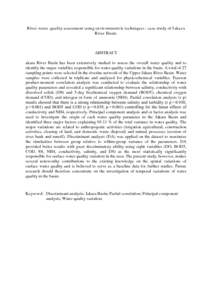Citation
Mustapha, Adamu and Aris, Ahmad Zaharin and Juahir, Hafizan and Ramli, Mohammad Firuz and Kura, Nura Umar
(2013)
River water quality assessment using environmentric techniques : case study of Jakara River Basin.
Environmental Science and Pollution Research, 20 (8).
pp. 5630-5644.
ISSN 0944-1344; ESSN: 1614-7499
Abstract
akara River Basin has been extensively studied to assess the overall water quality and to identify the major variables responsible for water quality variations in the basin. A total of 27 sampling points were selected in the riverine network of the Upper Jakara River Basin. Water samples were collected in triplicate and analyzed for physicochemical variables. Pearson product-moment correlation analysis was conducted to evaluate the relationship of water quality parameters and revealed a significant relationship between salinity, conductivity with dissolved solids (DS) and 5-day biochemical oxygen demand (BOD5), chemical oxygen demand (COD), and nitrogen in form of ammonia (NH4). Partial correlation analysis (r p) results showed that there is a strong relationship between salinity and turbidity (r p = 0.930, p = 0.001) and BOD5 and COD (r p = 0.839, p = 0.001) controlling for the linear effects of conductivity and NH4, respectively. Principal component analysis and or factor analysis was used to investigate the origin of each water quality parameter in the Jakara Basin and identified three major factors explaining 68.11 % of the total variance in water quality. The major variations are related to anthropogenic activities (irrigation agricultural, construction activities, clearing of land, and domestic waste disposal) and natural processes (erosion of river bank and runoff). Discriminant analysis (DA) was applied on the dataset to maximize the similarities between group relative to within-group variance of the parameters. DA provided better results with great discriminatory ability using eight variables (DO, BOD5, COD, SS, NH4, conductivity, salinity, and DS) as the most statistically significantly responsible for surface water quality variation in the area. The present study, however, makes several noteworthy contributions to the existing knowledge on the spatial variations of surface water quality and is believed to serve as a baseline data for further studies. Future research should therefore concentrate on the investigation of temporal variations of water quality in the basin.
Download File
![[img]](http://psasir.upm.edu.my/28902/1.hassmallThumbnailVersion/River%20water%20quality%20assessment%20using%20environmentric%20techniques.pdf)  Preview |
|
PDF (Abstract)
River water quality assessment using environmentric techniques.pdf
Download (188kB)
| Preview
|
|
Additional Metadata
Actions (login required)
 |
View Item |

